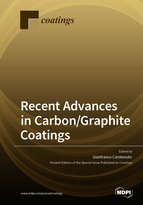Recent Advances in Carbon/Graphite Coatings
A special issue of Coatings (ISSN 2079-6412). This special issue belongs to the section "Thin Films".
Deadline for manuscript submissions: closed (31 December 2021) | Viewed by 17051
Special Issue Editor
Interests: functional materials; graphene; nanocomposites; polymer-embedded nanostructures
Special Issues, Collections and Topics in MDPI journals
Special Issue Information
Dear Colleagues,
At present, commodity plastics are used for many technological applications; however, their insulator/dielectric characteristics strongly limit industrial exploitation in fields related to electronics and electrotechnics. Conductive polymers are not mechanically robust and do not have adequate physical/chemical characteristics for most practical uses, while electrically conductive polymeric composites (e.g., metal-filled composites, MW-CNTs composites) still have strong limitations related to the high filling content required for electrical conduction. As a consequence, the physical modification of the polymer surface by carbon or graphite coatings may represent a further and very convenient way to provide the polymer surface of convenient antistatic properties or electrical conductivity. Owing to the good electrical conductivity of carbon and graphite, such coatings can be very thin (nanocoatings) or even optically transparent, leading to optical-grade conductive materials. In addition to the antistatics or electrical conductivity, surface modification of plastics by graphite nanocoatings provides plastic substrates with many other advantages such as self-lubrication, low friction, wear resistance, increased surface hardness, gas-barrier properties, chemical resistance, etc.
The main topics of this Special Issue are as follows:
- Techniques to deposit carbon/graphite nanocoatings on polymeric films;
- Methods for the surface characterization of carbon/graphite nanocoatings;
- Electrical, physical, and mechanical properties of carbon/graphite nanocoatings;
- Industrial applications of carbon/graphite nanocoated polymer films.
Dr. Gianfranco Carotenuto
Guest Editor
Manuscript Submission Information
Manuscripts should be submitted online at www.mdpi.com by registering and logging in to this website. Once you are registered, click here to go to the submission form. Manuscripts can be submitted until the deadline. All submissions that pass pre-check are peer-reviewed. Accepted papers will be published continuously in the journal (as soon as accepted) and will be listed together on the special issue website. Research articles, review articles as well as short communications are invited. For planned papers, a title and short abstract (about 100 words) can be sent to the Editorial Office for announcement on this website.
Submitted manuscripts should not have been published previously, nor be under consideration for publication elsewhere (except conference proceedings papers). All manuscripts are thoroughly refereed through a single-blind peer-review process. A guide for authors and other relevant information for submission of manuscripts is available on the Instructions for Authors page. Coatings is an international peer-reviewed open access monthly journal published by MDPI.
Please visit the Instructions for Authors page before submitting a manuscript. The Article Processing Charge (APC) for publication in this open access journal is 2600 CHF (Swiss Francs). Submitted papers should be well formatted and use good English. Authors may use MDPI's English editing service prior to publication or during author revisions.
Keywords
- graphite coatings
- carbon coatings
- polymers
- optically-transparent electrical conductors
- graphene
- functional materials






